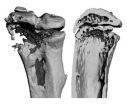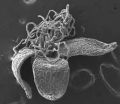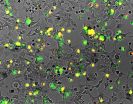(Press-News.org) This press release is available in French.
Montréal, February 13, 2013 – Since the beginning of time, living organisms have developed ingenious mechanisms to monitor their environment. As part of an international study, a team of researchers has adapted some of these natural mechanisms to detect specific molecules such as cocaine more accurately and quickly. Their work may greatly facilitate the rapid screening—less than five minutes—of many drugs, infectious diseases, and cancers.
Professor Alexis Vallée-Bélisle of the University of Montreal Department of Chemistry has worked with Professor Francesco Ricci of the University of Rome Tor Vergata and Professor Kevin W. Plaxco of the University of California at Santa Barbara to improve a new biosensing nanotechnology. The results of the study were recently published in the Journal of American Chemical Society (JACS).
Toward a new generation of screening tests
"Nature is a continuing source of inspiration for developing new technologies," says Professor Francesco Ricci, senior author of the study. "Many scientists are currently working to develop biosensor technology to detect—directly in the bloodstream and in seconds—drug, disease, and cancer molecules."
"The most recent rapid and easy-to-use biosensors developed by scientists to determine the levels of various molecules such as drugs and disease markers in the blood only do so when the molecule is present in a certain concentration, called the concentration window," adds Professor Vallée-Bélisle. "Below or above this window, current biosensors lose much of their accuracy."
To overcome this limitation, the international team looked at nature: "In cells, living organisms often use inhibitor or activator molecules to automatically program the sensitivity of their receptors (sensors), which are able to identify the precise amount of thousand of molecules in seconds," explains Professor Vallée-Bélisle. "We therefore decided to adapt these inhibition, activation, and sequestration mechanisms to improve the efficiency of artificial biosensors."
The researchers put their idea to the test by using an existing cocaine biosensor and revising its design so that it would respond to a series of inhibitor molecules. They were able to adapt the biosensor to respond optimally even with a large concentration window. "What is fascinating," says Alessandro Porchetta, a doctoral student at the University of Rome, "is that we were successful in controlling the interactions of this system by mimicking mechanisms that occur naturally."
"Besides the obvious applications in biosensor design, I think this work will pave the way for important applications related to the administration of cancer-targeting drugs, an area of increasing importance," says Professor Kevin Plaxco. "The ability to accurately regulate biosensor or nanomachine's activities will greatly increase their efficiency."
INFORMATION:
References on the study
The research was funded by the Italian Ministry of Universities and Research (MIUR), the Bill & Melinda Gates Foundation Grand Challenges Explorations program, the European Commission Marie Curie Actions program, the U.S. National Institutes of Health, and the Fonds de recherche du Québec Nature et Technologies.
On the Web:
The article Using Distal-Site Mutations and Allosteric Inhibition To Tune, Extend, and Narrow the Useful Dynamic Range of Aptamer-Based Sensors was published in the Journal of the American Chemical Society.
The laboratory of Professor Alexis Vallée-Bélisle: www.nanomachineslab.org
The laboratory of Professor Francesco Ricci: www.francescoriccilab.com
The laboratory of Professor Kevin Plaxco: http://web.chem.ucsb.edu/~plaxcogroup/
Université of Montreal Department of Chemistry : www.chimie.umontreal.ca
Notes: The University of Montreal is officially known as Université de Montréal.
Detecting cocaine 'naturally'
Canada-US-Italian research team develops a cocaine biosensor inspired from nature
2013-02-13
ELSE PRESS RELEASES FROM THIS DATE:
UTHealth: Alcohol consumption may be in response to smoking cessation
2013-02-13
HOUSTON – (Feb.12, 2013) – New findings by researchers at The University of Texas Health Science Center at Houston (UTHealth) School of Public Health may help identify situations in which smokers who are trying to quit are at a higher risk of relapse.
More than 1,200 people die in the United States every day from smoking-related illnesses. This is equivalent to three airplanes loaded with passengers crashing everyday in America. Smoking-related illnesses are the No. 1 cause of preventable deaths in the country, killing more Americans than drugs, homicides, suicides, ...
UCSB study of cocaine addiction reveals targets for treatment
2013-02-13
(Santa Barbara, Calif.) –– Scientists at UC Santa Barbara are researching cocaine addiction, part of a widespread problem, which, along with other addictions, costs billions of dollars in damage to individuals, families, and society. Laboratory studies at UCSB have revealed that the diminished brain function and learning impairment that result from cocaine addiction can be treated –– and that learning can be restored.
Karen Szumlinski, a professor in the Department of Psychological & Brain Sciences at UCSB, and her colleagues Osnat Ben-Shahar and Tod Kippin, have worked ...
Emerging cancer drugs may drive bone tumors
2013-02-13
Cancer drugs should kill tumors, not encourage their spread. But new evidence suggests that an otherwise promising class of drugs may actually increase the risk of tumors spreading to bone, according to researchers at Washington University School of Medicine in St. Louis.
The drugs, IAP antagonists, block survival signals that many cancer cells rely on to stay alive. Working in mice, the investigators found that targeting the same protein that makes tumors vulnerable to death also overactivates cells called osteoclasts, which are responsible for tearing down bone.
"These ...
Flu outbreaks modeled by new study of classroom schedules
2013-02-13
Classroom rosters combined with human-networking theory may give a clearer picture of just how infectious diseases such as influenza can spread through a closed group of people, and even through populations at large. Using high-school schedule data for a community of students, teachers, and staff, Penn State University's Marcel Salathé, an assistant professor of biology, and Timo Smieszek, a post-doctoral researcher, have developed a low-cost but effective method to determine how to focus disease-control strategies based on which individuals are most likely to spread the ...
Does race make a difference in monitoring of opioid pain therapy?
2013-02-13
Philadelphia, PA, February 12, 2013 – Opioids are frequently prescribed for pain management in noncancer patients, but recommended clinical guidelines for monitoring effectiveness and signs of drug abuse are often not implemented. Alongside well-documented racial disparities in prescribing opioid medications for pain, researchers report racial differences in the use of recommended opioid monitoring and follow-up treatment practices. The study is published in the current issue of PAIN®.
"In our study, we examined whether racial disparities exist in a more comprehensive ...
Ice age extinction shaped Australian plant diversity
2013-02-13
Researchers have shown that part of Australia's rich plant diversity was wiped out by the ice ages, proving that extinction, instead of evolution, influences biodiversity.
The research led by the University of Melbourne and University of Tasmania has shown that plant diversity in South East Australia was as rich as some of the most diverse places in the world, and that most of these species went extinct during the ice ages, probably about one million years ago.
The team's work was published in the prestigious journal Proceedings of the National Academy of Sciences.
Dr ...
Flood research shows human habits die hard
2013-02-13
New research has come up with ways to quickly assess flood damage to houses while also showing most people didn't intend to make changes to reduce their vulnerability after the 2010-11 floods in Australia.
Two separate reports from the National Climate Change Adaptation Research Facility released today show how lessons learned from households affected by the 2010-11 Australian floods can minimise damage under current and future climates.
The report Analysis of Damage to Buildings Following the 2010 Eastern Australia Floods evaluated the role of development controls ...
Blackbirds in the spotlight
2013-02-13
This press release is available in German.
Street lamps, traffic lights and lighting from homes are causing a rise in our night-time light levels. For some time now, scientists have suspected that artificial light in our towns and cities at night could affect plants, animals and us, humans, too. Studies, however, that have tested this influence directly are few. Scientists from the Max Planck Institute for Ornithology in Radolfzell, Germany, recently investigated how light conditions in urban areas at night affect European blackbirds (Turdus merula). They found that animals ...
Copper depletion therapy keeps high-risk triple-negative breast cancer at bay
2013-02-13
NEW YORK (February 13, 2013) -- An anti-copper drug compound that disables the ability of bone marrow cells from setting up a "home" in organs to receive and nurture migrating cancer tumor cells has shown surprising benefit in one of the most difficult-to-treat forms of cancer -- high-risk triple-negative breast cancer.
The median survival for metastatic triple-negative breast cancer patients is historically nine months. However, results of a new phase II clinical trial conducted by researchers at Weill Cornell Medical College and reported in the Annals of Oncology shows ...
UNC researchers discover gene that suppresses herpesviruses
2013-02-13
Chapel Hill, NC – Kaposi's sarcoma-associated herpesvirus (KSHV) and Epstein-Barr virus (EBV) hide within the worldwide human population. While dormant in the vast majority of those infected, these active herpesviruses can develop into several forms of cancer. In an effort to understand and eventually develop treatments for these viruses, researchers at the University of North Carolina have identified a family of human genes known as Tousled-like kinases (TLKs) that play a key role in the suppression and activation of these viruses.
In a paper published by Cell Host ...
LAST 30 PRESS RELEASES:
Geometry shapes life
A CRISPR screen reveals many previously unrecognized genes required for brain development and a new neurodevelopmental disorder
Hot flush treatment has anti-breast cancer activity, study finds
Securing AI systems against growing cybersecurity threats
Longest observation of an active solar region
Why nail-biting, procrastination and other self-sabotaging behaviors are rooted in survival instincts
Regional variations in mechanical properties of porcine leptomeninges
Artificial empathy in therapy and healthcare: advancements in interpersonal interaction technologies
Why some brains switch gears more efficiently than others
UVA’s Jundong Li wins ICDM’S 2025 Tao Li Award for data mining, machine learning
UVA’s low-power, high-performance computer power player Mircea Stan earns National Academy of Inventors fellowship
Not playing by the rules: USU researcher explores filamentous algae dynamics in rivers
Do our body clocks influence our risk of dementia?
Anthropologists offer new evidence of bipedalism in long-debated fossil discovery
Safer receipt paper from wood
Dosage-sensitive genes suggest no whole-genome duplications in ancestral angiosperm
First ancient human herpesvirus genomes document their deep history with humans
Why Some Bacteria Survive Antibiotics and How to Stop Them - New study reveals that bacteria can survive antibiotic treatment through two fundamentally different “shutdown modes”
UCLA study links scar healing to dangerous placenta condition
CHANGE-seq-BE finds off-target changes in the genome from base editors
The Journal of Nuclear Medicine Ahead-of-Print Tip Sheet: January 2, 2026
Delayed or absent first dose of measles, mumps, and rubella vaccination
Trends in US preterm birth rates by household income and race and ethnicity
Study identifies potential biomarker linked to progression and brain inflammation in multiple sclerosis
Many mothers in Norway do not show up for postnatal check-ups
Researchers want to find out why quick clay is so unstable
Superradiant spins show teamwork at the quantum scale
Cleveland Clinic Research links tumor bacteria to immunotherapy resistance in head and neck cancer
First Editorial of 2026: Resisting AI slop
Joint ground- and space-based observations reveal Saturn-mass rogue planet
[Press-News.org] Detecting cocaine 'naturally'Canada-US-Italian research team develops a cocaine biosensor inspired from nature




